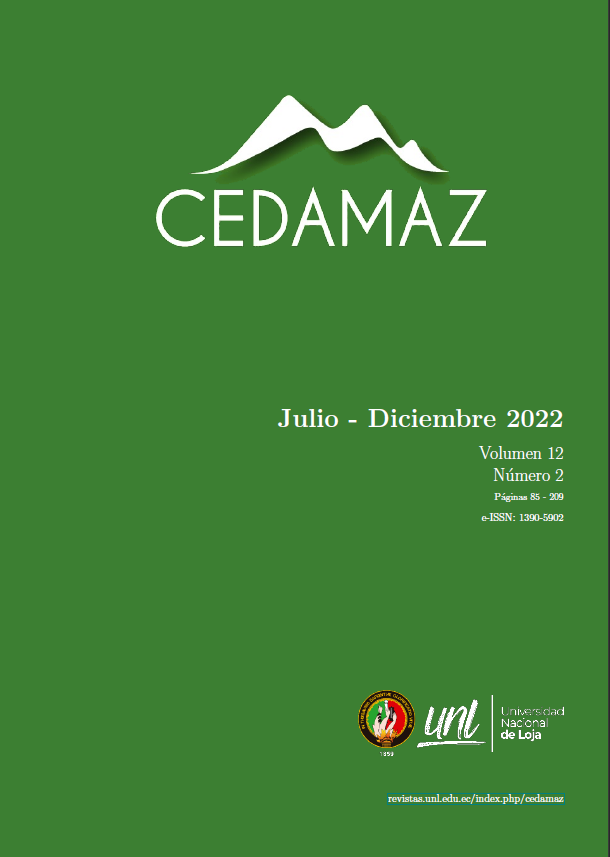Determination of the optimal disinfection factors using Bioperac in passion fruit, lemon and avocado from the Catamayo canton.
DOI:
https://doi.org/10.54753/cedamaz.v12i2.1219Keywords:
Postharvest, Disinfection, Bioperac, QualityAbstract
The determination and application of optimal disinfection parameters during the post-harvest process of fruits and vegetables is essential, it keeps the product in good condition and ensures that it does not constitute a risk to the consumer’s health. This research was focused on guaranteeing the quality and safety of agricultural products, specifically passion fruit, lemon and avocado, produced in the La Era neighborhood of the Catamayo Canton, province of Loja. For this, a sample size of 68 units per product was determined, subsequently preliminary tests were developed using five concentrations of Bioperac disinfectant (0.25; 0.50; 1.00; 1.50 and 2.00%) and by means of an organoleptic analysis established the definitive treatments; quality characteristics were evaluated in these: organoleptic, physical-chemical and microbiological; Finally, the production costs required in the post-harvest handling of the products were determined. The results obtained regarding the quality and safety analyzes of the definitive treatments indicated that the optimal disinfection factors for passion fruit, lemon and avocado correspond to 1.00% Bioperac, with a contact time of 3 minutes, at a temperature of refrigerated at 7 oC, packed in polyethylene (lemon) and polypropylene (passion fruit and avocado) bags. The shelf life for passion fruit and avocado was 35 days, while for lemon it was 49 days, whose production costs are lower than those offered by supermarkets in the city of Loja.References
CYGYC BIOCON. (2017). Ficha técnica de Oxadecco (2018). Procesos de cambio durante la maduración de la fruta.
Espinosa-Cruz, C., Valle, S. y Ybarra, M. (2014). Comportamiento postcosecha de frutos de aguacate ‘Hass’ afectado por temperatura y atmósfera modificada con microperforado. Revista fitotecnia mexicana, 37(3), 235-242. DOI: https://doi.org/10.35196/rfm.2014.3.235
Espinoza, A., Arreaza, R., Cardona, E., Méndez, J., Cañizares, A. y Buonafina, O. (2008). Efecto del empaque, temperatura y tiempo de almacenamiento sobre las características físicas de frutos de parchita (Passiflora edulis F. flavicarpa Degener). Revista Tecnológica ESPOL, 21(1) 55-63.
FAO. (2019). América Latina y el Caribe es responsable del 20% de la comida que se pierde a nivel mundial desde la poscosecha hasta el comercio minorista. FAO.
García-López, F. M., Herrera-Corredor, J. A., Pérez-Sato, J. A., Alatriste-Pérez, I. Contreras-Oliva, A. (2017). Relación entre el color y parámetros físicoquímicos del limón persa (Citrus latifolia T.) del centro de Veracruz, México.
Garmendia y Vero. (2006). Métodos para la desinfección de frutas y hortalizas. Horticultura. Revista de industria, distribución y socioeconomía hortícola: frutas, hortalizas, flores, plantas, árboles ornamentales y viveros, 6, 18-27. ISSN 1132-2950.
Instituto Interamericano de Cooperación para la Agricultura – IICA (2016). Un tercio de los alimentos producidos en el mundo se desperdicia.
Kishore, K., Pathak K., Shukla R. Bharali R. (2011). Effect of storage temperature on physic-chemical and sensory attributes of purple passion fruit (Passiflora edulis Sims). Journal of Food Science and Technology, 48(4):484-488. DOI: https://doi.org/10.1007/s13197-010-0189-8
Macas-Guachamín, G. (2013). Estudio de las características de calidad de pre y poscosecha en dos variedades de aguacate (Persea americana Mill) proveniente de dos localidades de la provincia de Pichincha. [Tesis de pregrado, Escuela Superior Politécnica de Chimborazo].
Mañes-Vinuesa, J., González, E., Rubio, C. y López, R. (2019). Informe del Comité Científico de la Agencia Española de Seguridad Alimentaria y Nutrición (AESAN) en relación a la seguridad del uso de una solución acuosa de peróxido de hidrógeno, ácido acético y ácido peracético como coadyuvante tecnológico para la desinfección bacteriana del agua de lavado de lechugas y zanahorias cortadas, ajos pelados, boniatos, caquis, mangos y aguacates en las plantas deprocesado. Revista del Comité Científico de la AESAN, 30.
Norma Técnica Ecuatoriana – NTE INEN 1755. (2013). Frutas frescas. Aguacate. Requisitos. (Segunda revisión). Quito – Ecuador.
Norma Técnica Ecuatoriana – NTE INEN 1757. (2016). Frutas frescas. Limón. Requisitos. (Segunda revisión). Quito – Ecuador.
Norma Técnica Ecuatoriana – NTE INEN 1971. (1994). Frutas frescas maracuyá. Requisitos. (Primera). Quito – Ecuador.
Núñez, K., Castellano, G., Ramírez, R., Sindoni, M., Hidalgo, P. y Marín, C. (2014). Efecto del estado de madurez sobre las características fisicoquímicas del limón criollo (Citrus aurantifolia Chris). Geominas, 43(67), 103-108.
Palacios-Andrade, G. C. (2019). Desarrollo de un prototipo de lechuga empacada en la parroquia Chuquiribamba, cantón Loja, provincia de Loja. Tesis de pregrado, Universidad Nacional de Loja.
PDOT de la parroquia El Tambo. (2014). Plan de Desarrollo y Ordenamiento Territorial de la parroquia El Tambo.
Puga-Muima, A. M. (2020). Manejo poscosecha de granadilla en la parroquia Yangana, cantón y provincia de Loja. DOI: https://doi.org/10.47840/ReInA.3.1.1059
Rojas-Paccha, V. C. (2019). Evaluación de la vida útil de la zanahoria aplicando tres desinfectantes diferentes, en la parroquia Chuquiribamba, Cantón y Provincia de Loja. Yara. (2018). Influir en la acidez de cítricos.
Published
How to Cite
Issue
Section
License
Copyright (c) 2022 CEDAMAZ

This work is licensed under a Creative Commons Attribution-NonCommercial-NoDerivatives 4.0 International License.
Those authors who have publications with this journal, accept the following terms:
- After the scientific article is accepted for publication, the author agrees to transfer the rights of the first publication to the CEDAMAZ Journal, but the authors retain the copyright. The total or partial reproduction of the published texts is allowed as long as it is not for profit. When the total or partial reproduction of scientific articles accepted and published in the CEDAMAZ Journal is carried out, the complete source and the electronic address of the publication must be cited.
- Scientific articles accepted and published in the CEDAMAZ journal may be deposited by the authors in their entirety in any repository without commercial purposes.
- Authors should not distribute accepted scientific articles that have not yet been officially published by CEDAMAZ. Failure to comply with this rule will result in the rejection of the scientific article.
- The publication of your work will be simultaneously subject to the Attribution-NonCommercial-NoDerivatives 4.0 International (CC BY-NC-ND 4.0)









